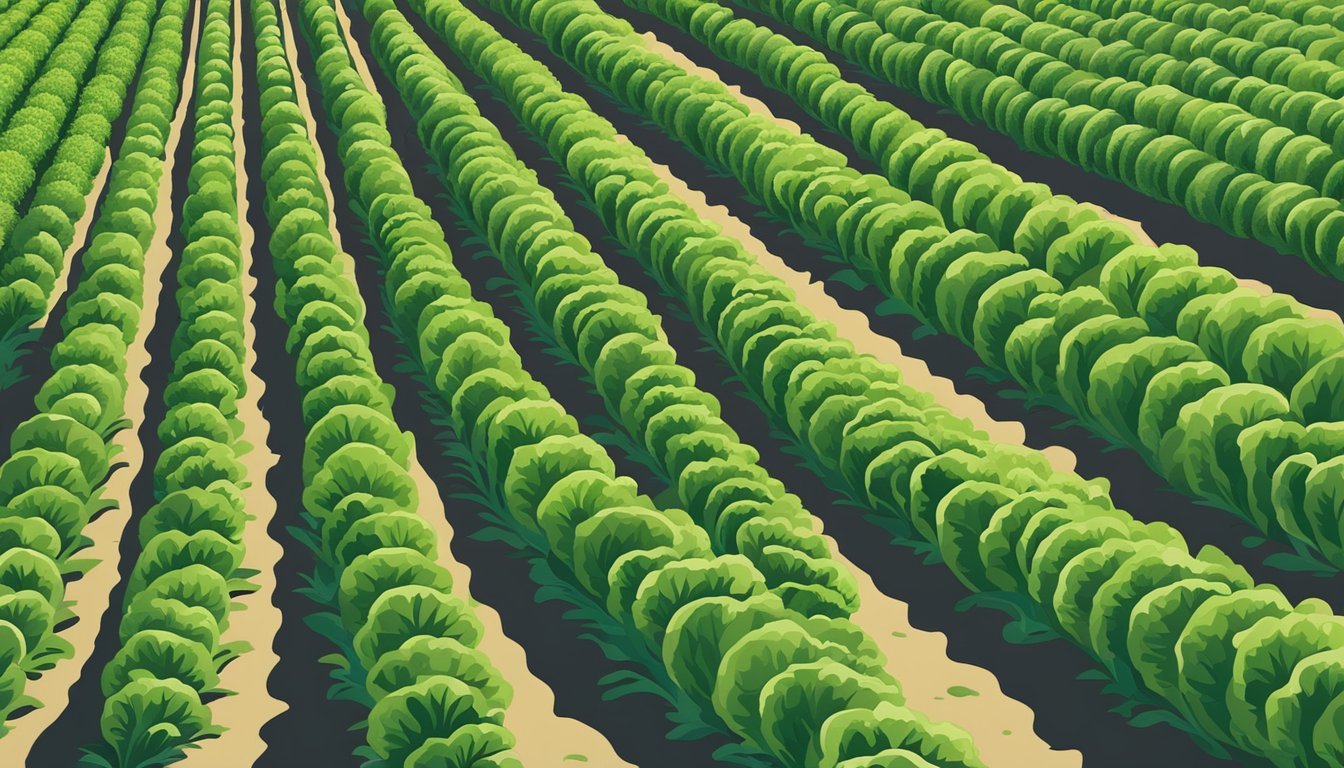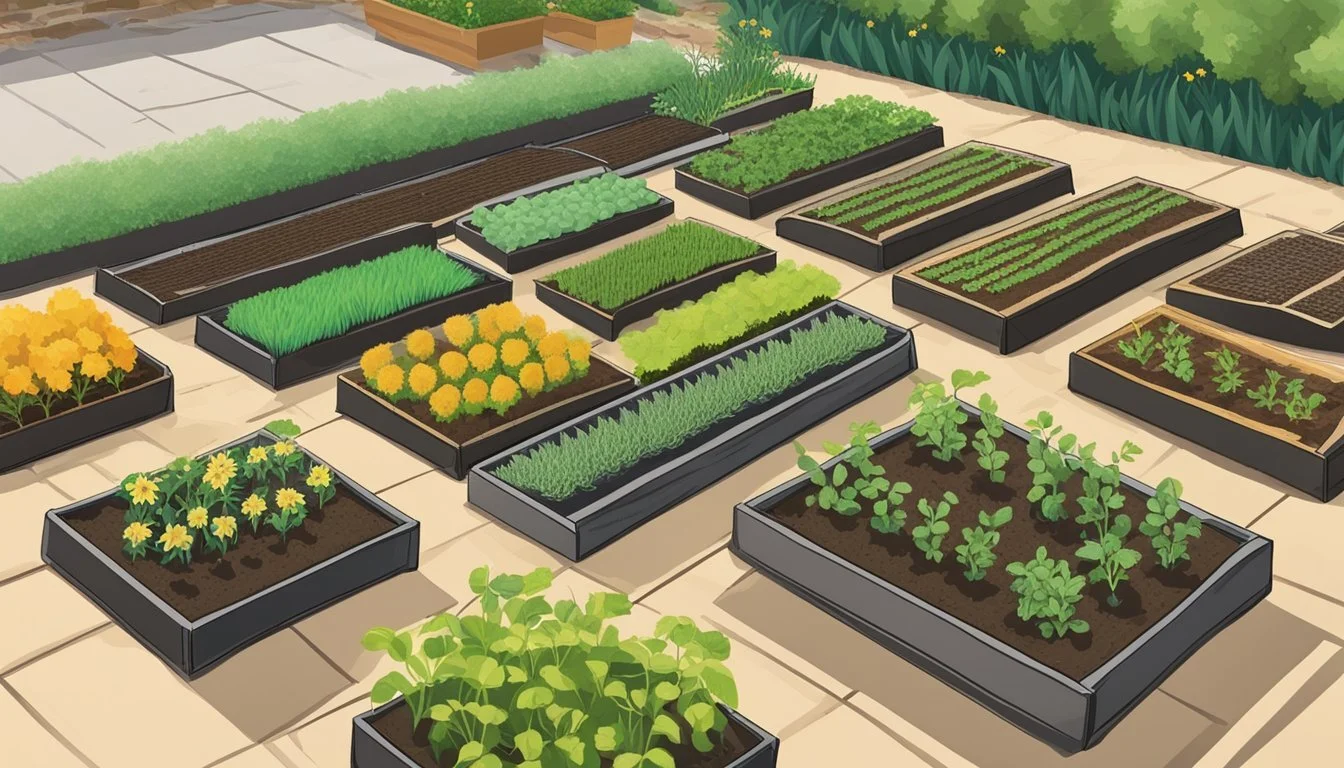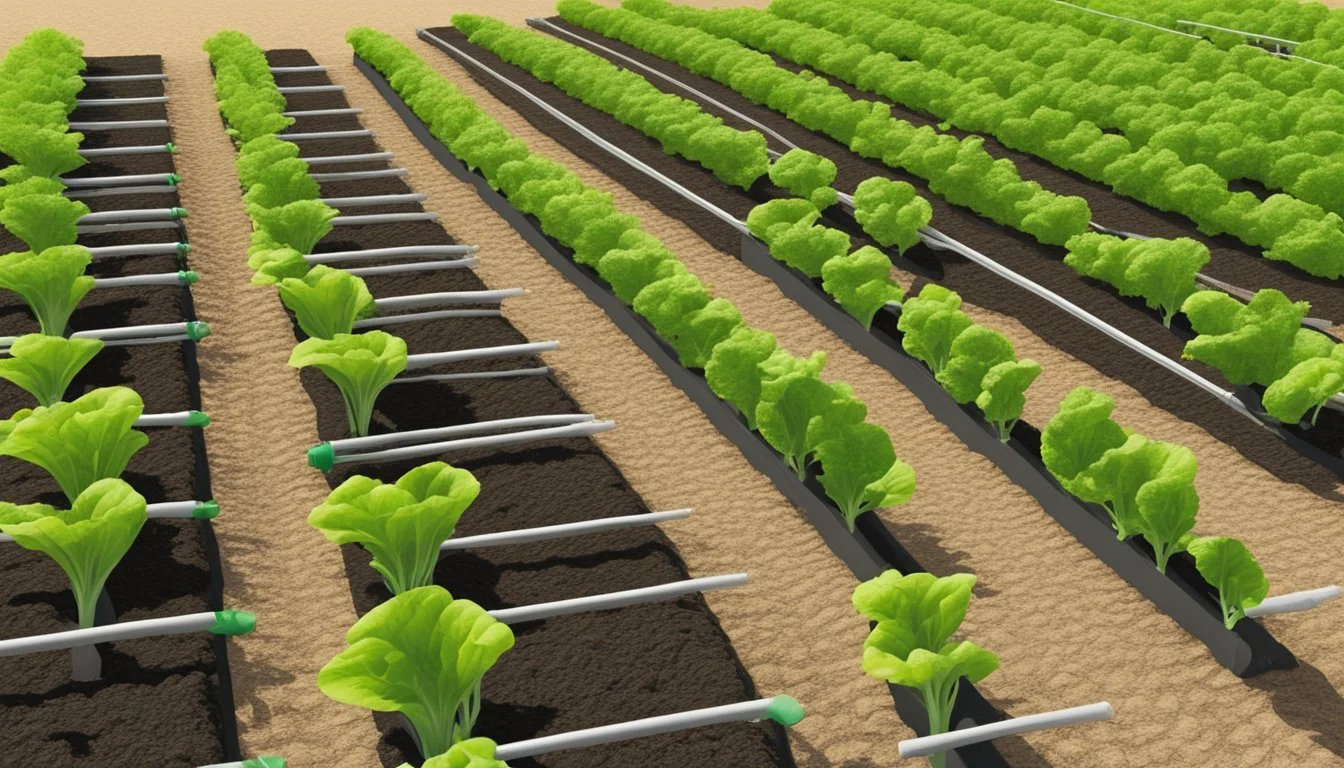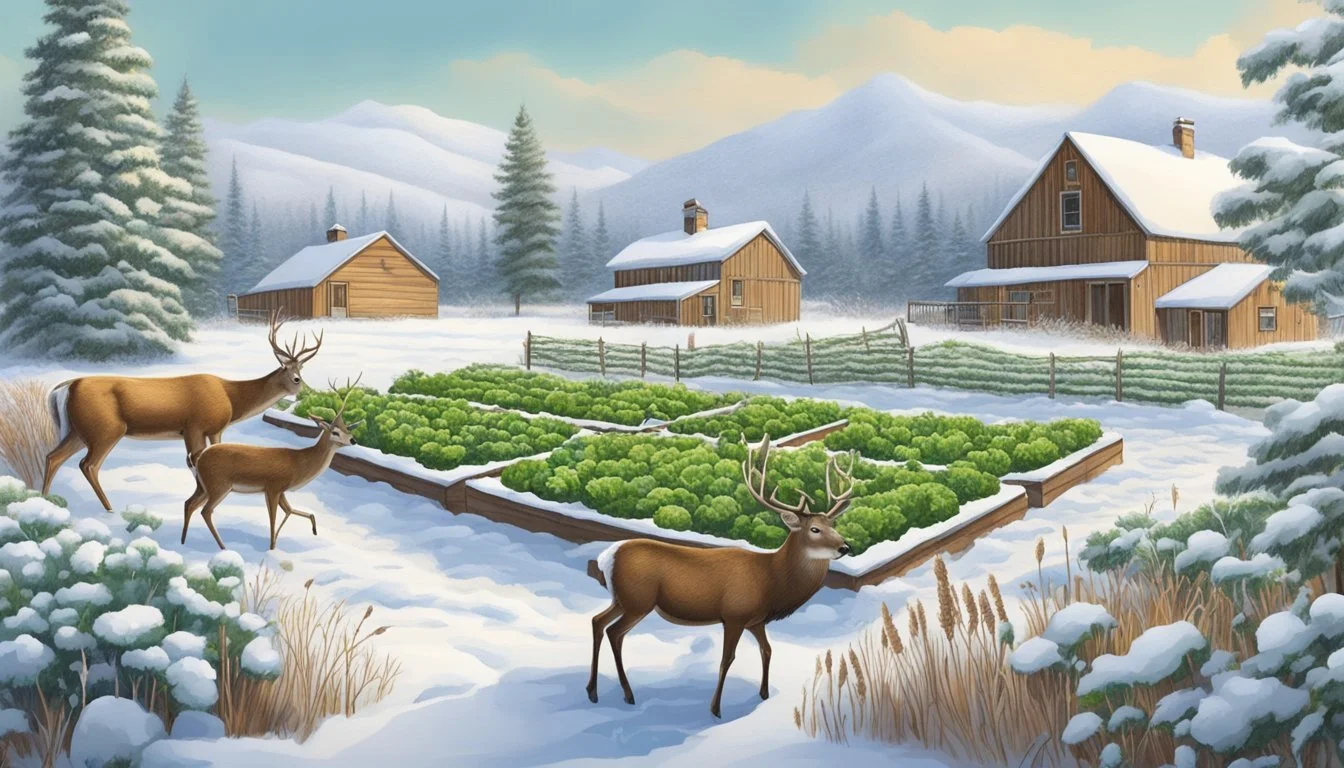Vegetable Gardening in Wyoming
A Practical Guide to High-Altitude Crops
This Article is Part of Our Guide on Vegetable Gardening by State
Vegetable gardening in Wyoming presents a unique set of rewards and challenges due to the state's diverse climate and elevation range. As gardeners navigate the variables of Wyoming's weather patterns, they learn to adapt their practices to accommodate a growing season that is generally shorter and cooler compared to much of the country. Success hinges on an understanding of the local environment, including the first and last frost dates, and selecting plants that can thrive within these constraints.
Wyoming falls within USDA plant hardiness zones 3-6, which indicates the region’s capacity for supporting various types of vegetation based on the minimum temperatures. Gardeners can benefit from choosing vegetables like lettuce, which is known for its adaptability, requiring minimal space and care, making it an ideal candidate for urban gardens or small spaces. It underscores the importance of plant selection where cold-hardy vegetables can yield a robust harvest even in Wyoming’s challenging conditions.
In addition to selecting the right vegetables, gardeners must also focus on soil preparation, proper timing for planting and harvesting, and utilizing techniques that can extend the growing season, such as the use of raised beds or cold frames. Those who take the time to learn and employ the strategies suited to Wyoming’s unique climate can enjoy the rich experience of growing a fruitful vegetable garden despite the shorter growing period.
Understanding Wyoming's Climate and Hardiness Zones
In Wyoming, vegetable gardening success hinges on a clear understanding of the region's distinct climate and its USDA plant hardiness zones.
Hardiness Zone Overview
Wyoming encompasses a range of USDA plant hardiness zones, predominantly Zone 3 through Zone 6. These zones are determined by the average annual minimum winter temperatures. Here's a brief overview:
Zone 3: Areas with temperatures dipping as low as -40 to -30 degrees Fahrenheit
Zone 4: Regions experiencing minimum temperatures between -30 to -20 degrees Fahrenheit
Zone 5: Locations with winter lows from -20 to -10 degrees Fahrenheit
Zone 6: Parts of Wyoming that typically have milder winters, ranging from -10 to 0 degrees Fahrenheit
Impact of Wyoming's Climate on Gardening
The climate in Wyoming is predominantly semi-arid and continental, which brings about hot summers and cold winters. This climate results in a shorter growing season, especially in areas designated as Zone 3 and Zone 4, where cold temperatures can arrive early in the fall and linger well into the spring. Selecting plants that can thrive in these conditions is crucial for a successful garden. Gardeners must be mindful of:
Spring Frosts: Even if daytime temperatures warm up, gardeners must watch for spring frosts that can damage or kill tender plants.
Summer Heat: While warm days are ideal for growing, some plants may require additional water and care to cope with the intense summer heat.
Variable Weather: Quick weather changes are common, so resilience and adaptability are key attributes of both plants and gardeners in Wyoming.
By respecting these factors, gardeners in Wyoming can maximize their chances of cultivating a thriving garden that is in harmony with their local environment.
Essential Steps for Starting Your Garden
When beginning a vegetable garden in Wyoming, an individual must select an optimal location, prepare the soil properly, and choose vegetables suited to the short growing season and cooler climate.
Selecting the Right Location
Gardeners should look for a site that receives at least six to eight hours of sunlight per day, as most vegetables need ample sunlight to thrive. They need to consider wind exposure as well and, if possible, choose a spot with some protection to prevent drying out of both soil and plants. Proximity to a water source is also critical for easy irrigation.
Soil Preparation and Improvement
Before planting, it is advantageous to conduct a soil test in order to understand the soil type, pH level, and nutrient profile. Amendments may need to be added to the soil, such as organic matter, to improve water retention and nutrient content. Tilling the soil to a depth of 8 to 12 inches allows for better root growth. Incorporating compost or well-aged manure will significantly boost soil fertility and structure.
Choosing the Right Vegetables
Gardeners should consult seed catalogs and select vegetable varieties that can withstand Wyoming’s climate challenges, favoring those with shorter maturation times. Cold-hardy vegetables like lettuce, spinach, radishes, and peas are ideal for planting in the spring. Gardeners can also consider crops like carrots and beets that grow well in cool conditions. It's important to plan crops around the state’s first and last frost dates to ensure optimal grow times.
Vegetable Planting and Scheduling
Effective vegetable gardening in Wyoming hinges on understanding the local climate, scheduling planting dates around frost, and choosing the right time for transplanting. With Wyoming’s varying hardiness zones and unpredictable weather, timing becomes critical for a successful harvest.
Understanding Frost Dates
In Wyoming, gardeners must pay close attention to the first and last frost dates to maximize their growing season. Frost dates are essential as they determine when it is safe to plant frost-sensitive vegetables. The state spans USDA plant hardiness zones 4 through 6, where these dates can vary widely.
Zone 4: Last frost mid-late May; first frost early-mid September.
Zone 5: Last frost early-mid May; first frost mid-late September.
Zone 6: Last frost late April-early May; first frost late September-early October.
Growing Season Timelines
The growing season in Wyoming can be short, often ranging from 117 to 130 days. Gardeners should prioritize cool-season vegetables that can withstand lower temperatures and are known to thrive in shorter seasons. Vegetables such as lettuce, radishes, and spinach should be sown earlier as they can endure cooler soils and even light frosts.
Optimal Planting Timelines for Cool-Season Vegetables:
Vegetable Planting Timeframe Radishes As soon as soil can be worked Leaf Lettuce 2-4 weeks before last frost date Spinach 4-6 weeks before last frost date Peas 4-6 weeks before last frost date
Vegetable Transplanting Guide
Transplants offer a head start for vegetables in Wyoming's short growing season. It's advised to start seeds indoors and move transplants to the backyard after the risk of frost has passed. Gardeners often begin this process several weeks before the last expected frost date. For instance, tomatoes and peppers should be started indoors roughly 6-8 weeks before transplanting them into the garden.
Transplant Timing Guide:
Cabbage - Start indoors 6-8 weeks before last frost, transplant 2-3 weeks before last frost.
Broccoli - Start indoors 6-8 weeks before last frost, transplant 2-4 weeks before last frost.
Tomatoes - Start indoors 6-8 weeks before last frost, transplant after last frost without fail.
It is crucial for gardeners to monitor weather forecasts regularly, as Wyoming weather can be unpredictable. This allows for adjustments to the planting schedule if sudden frost warnings are issued.
Caring for Your Vegetable Garden
Successful vegetable gardening in Wyoming requires diligent care, proper watering, and vigilant pest and disease management. Regular maintenance and appropriate fertilization are also crucial for a bountiful harvest.
Watering and Irrigation
Efficient watering is vital in the arid Wyoming climate. Gardeners should aim for deep watering that encourages strong root development. The use of drip irrigation systems can conserve water and target the plant's roots directly, minimizing evaporation and wastage.
Frequency: Depending on the weather, a thorough weekly watering may be sufficient.
Best Time to Water: Early morning or late afternoon to reduce water loss from evaporation.
Pest and Disease Management
Wyoming gardens may encounter pests like aphids and common diseases that can be managed through integrated pest management (IPM):
Monitoring: Regularly inspect plants for signs of pests or disease.
Prevention: Use disease-resistant seeds and plants where possible.
Intervention: Apply organic or chemical treatments only as needed to minimize impact on beneficial insects.
Common Pests and Control Methods:
Pest Control Method Aphids Insecticidal soap or neem oil Beetles Handpicking or pheromone traps
Maintenance and Fertilization
Routine maintenance tasks are pivotal to ensure the health and productivity of a vegetable garden:
Weeding: Keep the garden free of weeds that compete for nutrients and water.
Mulching: Apply mulch to conserve moisture and suppress weeds.
Fertilization: Use a balanced fertilizer to provide essential nutrients, following recommended rates to avoid overfertilization.
Harvesting should be done at the peak of ripeness for optimal flavor and nutrient content, and can often encourage further production of vegetables like beans and lettuce.
Specific Gardening Techniques
In Wyoming's challenging growing environment, gardeners often turn to specialized techniques such as raised bed gardening and container and vertical gardening to maximize their yield and extend the growing season.
Raised Bed Gardening
Raised bed gardening involves the creation of elevated soil beds, typically enclosed with wood, stone, or concrete blocks. This technique offers several advantages in Wyoming:
Improved Drainage: Raised beds facilitate better drainage, crucial in areas with heavy soil.
Soil Quality Control: Gardeners can fill raised beds with a mix of topsoil, compost, and other organic materials, such as peat moss, to create an ideal growing medium.
Extended Growing Season: The soil in raised beds warms up more quickly in the spring, allowing for an earlier start to the planting season.
Select a location that receives at least 6-8 hours of sunlight daily.
Build or purchase a raised bed frame, ideally 6 to 8 inches high.
Fill with a quality soil mixture, considering a blend of:
60% topsoil
30% compost
10% organic amendments (like peat moss)
Container and Vertical Gardening
Container gardening empowers individuals with limited space to grow vegetables on patios, balconies, or rooftops using pots, tubs, or planters. Vertical gardening goes a step further by utilizing structures like trellises or towers to grow plants upwards, which is ideal for climbers such as beans and cucumbers.
Key benefits include:
Portability: Containers can be moved to optimize sunlight exposure.
Soil Containment: Similar to raised beds, soil quality is easily managed, and issues like soil-borne diseases can be mitigated.
Efficient Use of Space: Vertical gardening creates "living walls," which can result in higher yields per square foot.
Useful tips for successful container and vertical gardening:
Choose containers with adequate drainage holes to prevent root rot.
Mulch the top layer with straw or wood chips to retain moisture.
Select suitable plants for containers, such as herbs, lettuce, and tomatoes.
Install a sturdy trellis or support system for vertical growth, ensuring it can bear the weight of mature plants.
Crops and Varieties Suited for Wyoming
When selecting crops for gardening in the unique climate of Wyoming, choosing cold-hardy and short-season varieties is crucial. Wyoming’s growing season can be short and gardens may face challenges such as high elevation and variable weather.
Vegetables like kale, spinach, and lettuce thrive in Wyoming's cool temperatures, making them excellent choices for early spring planting. These leafy greens can handle light frosts, allowing for an extended harvesting season.
Root vegetables such as carrots, beets, and radishes are also well-suited for Wyoming’s soil and climate. Radishes are particularly notable for their rapid growth, and can even act as a companion plant, facilitating the growth of neighboring crops.
Vegetable Variety Suggestion Planting Tip Tomatoes Early Girl, Celebrity Use starter plants; provide cover Peppers King of the North Use raised beds for warm soil Peas Sugar Snap Plant in fertile, well-drained soil Beans Bush Blue Lake Direct sow after last frost Squash Early Prolific Straightneck Harvest young for best flavor
For summer vegetables, bush beans, cucumbers, and squash are among the viable options that can mature quickly before the first frost arrives. Starting tomatoes and peppers indoors or purchasing starter plants can be beneficial due to the shorter growing season.
Hearty vegetables like broccoli, cabbage, and brussels sprouts need to be planted in the summer for a fall harvest. They generally prefer cooler temperatures and will yield produce into the cooler months.
The staple sweet corn can be grown successfully in warmer areas of Wyoming but requires careful selection of early maturing varieties.
Expanding beyond vegetables, perennials like asparagus and rhubarb adapt well once established and can provide a crop year after year with minimal care.
This careful selection ensures a bountiful and diverse garden from the early days of spring into the cool embrace of fall in Wyoming.
Dealing with Wildlife and Extreme Weather
Gardeners in Wyoming must contend with various wildlife such as deer, rabbits, squirrels, and slugs, as well as extreme weather conditions, including strong winds, variable frost dates, extreme heat, and intense cold. To strike a balance between nature and cultivation, they need to adopt strategic methods.
Wildlife Encounters:
Deer: To deter deer, installing robust fencing, at least 8 feet high, is effective. Alternatively, gardeners can plant deer-resistant vegetation on the periphery.
Rabbits: A fence with fine mesh extending into the ground about 6-10 inches can help keep rabbits at bay.
Squirrels: These critters can be troublesome; use of squirrel-proof bird feeders and planting bulbs they find less appealing helps.
Slugs: Hand picking and barriers of diatomaceous earth or copper can control slug populations.
Weather Resistances:
Frost Dates: Cold frames and hoop houses extend the season by protecting against early and late frosts.
Extreme Heat: Using mulch conserves moisture and maintains root temperatures. Shade cloths can protect plants during peak heat.
High Winds: Windbreaks such as shrubs, trees, or synthetic barriers prevent wind damage to plants.
Cold Hardy Varieties: Choosing cold hardy seeds adapted to Wyoming’s climate gives a stronger start.
By employing these practical strategies, gardeners in Wyoming can minimize losses and maximize the productivity of their vegetable gardens, despite challenges from wildlife and weather.
Harvest and Post-Harvest Handling
When harvesting vegetables in Wyoming, gardeners must adapt to the shorter growing season and volatile weather. Strategic timing and handling are crucial for maximizing yields and preserving vegetable quality post-harvest.
Harvest Times and Techniques
Gardeners should monitor their vegetables closely as the ideal harvest time approaches, often just before full maturity. Cold-hardy vegetables like carrots and spinach can withstand a light frost and might even become sweeter after a cold snap. They must use proper techniques to avoid damage:
Root vegetables such as beets and carrots should be gently lifted from the soil using a garden fork to prevent bruising.
Leafy greens like lettuce can be harvested by cutting the leaves, allowing the plant to continue producing.
Pods from peas should snap off easily with a consistent downward pull, indicating they're ready for harvest.
Storing Vegetables and Extending Harvest
Proper storage can extend the life of freshly harvested vegetables. Wyoming gardeners can use various methods to keep their vegetables fresh:
Cool, humid storage: Root vegetables store well in a root cellar or similar cool, moist environment.
Dry, cool storage: Onions and garlic need dry conditions and should be cured before long-term storage.
Refrigeration: Leafy greens and cruciferous vegetables like broccoli should be refrigerated to maintain freshness.
Extending the harvest into the colder months involves selecting cold-hardy vegetables and utilizing protective measures:
Mulching: Applying straw or leaves around plants can protect roots from sudden temperature drops.
Cold frames: These structures shield plants from frost while allowing them to continue growing in cooler temperatures.
By following these specific harvest and storage guidelines, Wyoming gardeners can enjoy their vegetable yields well beyond the typical growing season.
Community and Further Resources
In Wyoming, the success of vegetable gardening hinges on tapping into local expertise and online educational platforms. These resources offer tailored advice, suitable plant selections, and strategies for overcoming regional growing challenges.
Local Nurseries and Gardening Groups
Local nurseries in cities like Laramie are integral to the gardening community in Wyoming. They provide not only plants that are acclimated to the specific planting zones of the state but also invaluable advice on vegetable gardening relevant to Wyoming's unique climate. Gardening groups often form around these hubs, fostering a network of support where gardeners can share tips on nurturing specific crops suited to short growing seasons and cooler summer temperatures.
Notable Gardening Groups and Nurseries:
Laramie Garden Club: A community-focused group offering insights on vegetable varieties thriving in Wyoming.
Green Thumb Nursery (Laramie): A reputable source for cold-hardy vegetable starts and gardening supplies.
Online Resources and Websites
The digital sphere offers an array of resources for Wyoming vegetable gardeners seeking knowledge and support. Authentic websites like the University of Wyoming's Gardening Resources Page provide up-to-date, research-based information on everything from soil preparation to pest management. Moreover, interactive platforms enable gardeners to connect with agricultural experts, access grants, and participate in educational workshops.
Recommended Online Resources:
UW Gardening Resources: A comprehensive guide to gardening in Wyoming, including a seasonal calendar.
Kids Gardening: Offers curriculum and funding opportunities aimed at gardening education for youth.
Rooted in Wyoming: Connects gardeners with teaching resources and community programs geared towards sustainable horticulture practices.








